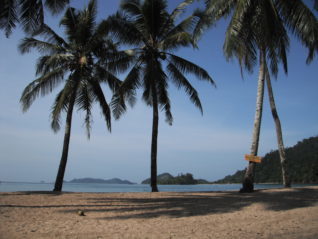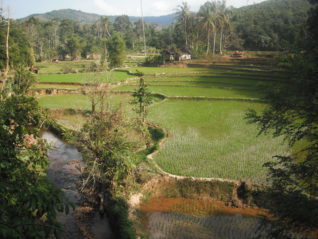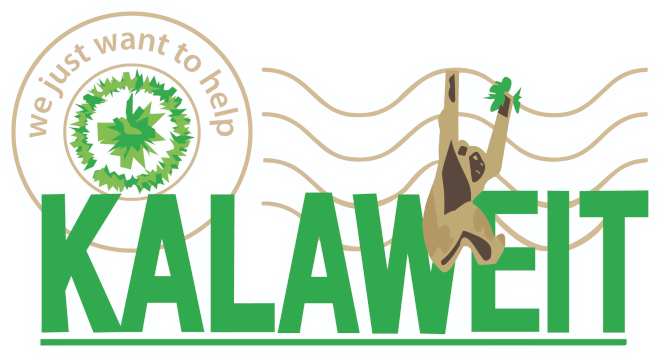Beauty and richness
of indonesian nature
Composed of 17,000 islands, the largest of which are Borneo (Kalimantan), Sumatra, Java and Sulawesi, Indonesia…
Indonesia is the largest archipelago in the world and is home to the richest flora and fauna on the Asian continent.
10% of the planet’s tropical forests are found here; ecosystems that are extremely rich in animal and plant species. The country is home to one of the most diverse wildlife in the world; 15% of the total number of primate species are recorded there, including 7 species of gibbons out of the existing 17.
Some emblematic species are endemic to certain islands: orangutans (Borneo and Sumatra), proboscis monkeys (Borneo), elephants (Sumatra), Kloss gibbons (Sumatra), agile gibbons and siamangs (Sumatra), white bearded gibbons and Mullerian gibbons (Borneo), Moloch gibbons (Java), Komodo dragons, etc.
Most of the tigers, elephants, rhinos and leopards have disappeared, victims of hunting and poaching but gibbons and orangutans, emblematic species of this part of the world, still survive in these precious ecosystems and new species are regularly discovered in the Indonesian forests.
Indonesian landscapes are varied: fine sandy beaches in Sumatra, Lombok, the Gili and Celebes islands, tropical forests in Borneo and Sumatra, volcanoes including the famous, still active Merapi, on the island of Java, considered the most dangerous in the archipelago and one of the most dangerous in the world.
The majority of volcanoes are located on the Sonde chain which is 3,000 km long. There are 127 volcanoes in Indonesia.
Indonesia’s forests are the third largest in the world after those in the Amazon and the Congo Basin but are unfortunately threatened by deforestation.



Gibbons
Gibbons are primates belonging to the Hylobatidae family. They are members of the great ape family, together with gorillas, bonobos, orang-utans and chimpanzees.
Like human beings and the other great apes, gibbons are members of the superfamily Hominoidea.
They are found in the tropical forests of South-East Asia, in Thailand, Cambodia, Vietnam, China, Laos, Bangladesh, Burma (Myanmar), India, Malaysia and Indonesia.
There are 17 species of gibbons, all threatened as a result of destruction of their habitat.
The followings species are only found in Indonesia:
- Sumatra : agile gibbon (Hylobates agilis), white-handed gibbon (Hylobates LAR), siamang (Symphalangus syndactylus), Kloss gibbon (Hylobates Klossii),
- Borneo (Kalimantan) : white-beared gibbon (Hylobates albibarbis), Müller gibbon (Hylobates muelleri),
- Java : Moloch gibbon (Hylobates Moloch) also named Javan gibbon or silvery gibbon.
Gibbons are arboreal apes, moving through the trees with remarkable speed and agility.
They feed on fruit, leaves, flowers, and sometimes insects, eggs or birds.
They measure from 70 cm to 1 m in height and can live to the age of 40 years. Gibbons cannot swim and are almost never seen on the ground.
They share their territory with other primates, such as orangutans and macaques, who live slightly lower down in the trees.
Gibbons are monogamous and the female gives birth to a single baby after 7 months of gestation (with one birth every 2-4 years).
The young gibbons are weaned around the age of 2 years and stay with their parents until the age of 7 years, before setting off in search of a partner with whom they will spend the rest of their life. The male and female gibbons share dominance, but the babies are only carried by the female.
Each couple occupies a territory of around 12 hectares, ownership being declared every morning by a highly specific song.

This song is one of the causes of the disappearance of gibbons:
It is allowing poachers to easily locate the animals. Gibbons are hunted to furnish the illegal trade in wild animals or for traditional medicine.
They are highly territorial animals, capable of killing one other for a territory. Man is the main predator of gibons.
Siamangs, the largest of the gibbons, can be recognised by the characteristic that two of their fingers on each hand are joined together. They are mainly found on the island of Sumatra. Siamangs possess a throat sac, or gular sac, which inflates when they sing.
The 17 gibbon species are protected by Annexe 1 of the Washington Convention dated March 3rd 1973, ratified by France on December 31st 1992. Gibbons are on the Red List of the IUCN (International Union for Conservation of Nature). In other words, they are considered to be in danger of extinction in the short term.
More than 3,000 gibbons are thought to be illegally kept in captivity by private individuals in Borneo alone. There are thought to be no more than 80,000 living wild in the whole of South-East Asia. The Hainan gibbon in China (Nomascus hainanus) is the most critically endangered species, only 28 of these animals remains in the wild in 2015. Approximately between 1,500 Kloss gibbons are still living wild on the Mentawai Islands, off the coast of Sumatra.
Deforestation
Indonesia is one of the most deforested countries in the world.
In 50 years, it has lost more than 50% of its forests, which covered 75% of its territory. The islands of Sulawesi, Java, Sumatra and Borneo are the most affected, the latter 2 having lost between 60 and 70% of their forests to oil palm plantations.
Illegal logging of tropical timber, rapid increase in the number of oil palm farms, clearing to increase arable land and settle migrant populations, gigantic forest fires are why Indonesia’s tropical forests are disappearing at a worrying rate. The equivalent of 3 football fields disappears every minute in Indonesia.
With 47 million tons of palm oil and 4.6 million tons of palm kernel oil (fruit kernel) produced in 2019, Indonesia has become the top palm oil producer, ahead of Malaysia, an industrial culture that causes atmospheric pollution during the conversion of forests and subsequently of rivers, with the dumping of fertilisers and pesticides…
Any company obtaining a concession from the provincial government can destroy the forest as it sees fit. These concessions may be ancestral lands belonging to forest people such as the Orang-Rimba of Sumatra or the Penan of Borneo, from whom they are stolen.


The palm oil disaster…
With a size of up to 25,000 hectares per farm, and consortia amounting to several hundred thousand hectares of monoculture, when the focus is on a forest region it is an environmental disaster. Palm oil manufacturers encourage small landowners, often villagers, to plant palm trees on their plots, which causes more and more fires during dry seasons. These areas are rarely taken into account in official figures. The administrative situation is such that some oil palm farms are present in national parks. Illegal logging has been recognised in 37 of the 41 national parks through surveys by the Indonesian authorities.
The toxic fumes that regularly cover Borneo and Sumatra, increasingly exasperate the local population. But the country is ruled with an iron fist, and Indonesians are not in the habit of protesting.
Some years, the deforestation figures are reduced, which would seem to be a positive signal. In reality, these decreases are often due to rainy weather which prevents the plots from burning but this will be done during the next dry season…
The production of palm oil has tripled in 20 years and its use as fuel greatly accelerates this progression. However, a ray of hope comes from Western countries, such as France, where the general public is increasingly reluctant to buy products containing palm oil.
Palm oil
(Elaeis Guinensis)
Native to West Africa, it was first imported to Malaysia as an ornamental plant, and began to be cultivated there for its oil around 1917. In the 1960s, its cultivation accelerated and grew and was extended to Indonesia. Its fruits and seeds, which are rich in oil, are used as industrial food, cosmetics and agro-fuels.
It is 15-25 m tall, with leaves 5-7 m long. The fruit contains an oval kernel which contains the seed called the palm kernel which is rich in lipids and which provides palm kernel oil. The orange-yellow pulp contains nearly 50% of lipids which constitute the palm oil. Palm nuts (fruits) are grouped into bunches of up to 1,500 fruits.
The palm tree is productive. In 3 years it reaches the stage where it can be exploited for up to 20 years. The bunches are harvested by hand continuously, 2 to 3 times a year, which makes 10 to 30 tonnes of bunches per hectare and per year.
This gigantic monoculture destroys the biodiversity of tropical forests.
The numerous illegal fires (up to 80% of fires), which are deliberately uncontrolled, destroy hundreds of thousands of hectares of forests in one year. The scorched land is then attached to conversion forests and donated by the state to plantation companies, generally Asian. It is the face of the fait accompli. In some years, the situation is such that airports in Borneo, Sumatra or neighbouring countries (Singapore, Malaysia, Vietnam, etc.) have to be closed because of the smoke which makes all flight impossible.
A film that says more than a long speech: GREEN by Patrick Rouxel

Other names for palm oil
- Vegetable oil
- Elaeis guinensis
- Palm oil kernal
- Palm fruit oil
- Anything with “palm”
- And many others…
Wildlife trafficking
The disappearance of natural habitats endangers the survival of wildlife. It worsens the trafficking of wild animals because access to the forest and its resources is facilitated.
Globally, this traffic is in 3rd position after that of drugs and weapons. In contact with humans, wild animals can develop diseases that decimate their populations.
In Indonesia, some species are captured to be eaten such as bats (fruit bats) or proboscis monkeys, endemic to Borneo, which are close to extinction. Despite their status as a protected species, they are hunted for sale in the local markets or are directly consumed by those who caught them.
Other species, such as pangolins or bears, are destined, dead or alive, for the Chinese market for gastronomy or pharmacopoeia (and its beliefs …). Culinary habits vary; in some places dogs are eaten, elsewhere the flower men of the Mentawai Archipelago eat Kloss gibbons.
Baby gibbons are captured to be sold as live toys.
Very fragile, their lifespan is generally short, the stress of captivity in bad conditions condemns them rapidly to death. If they survive into adulthood, they become unmanageable and are often killed by their owners.
Few animals escape this trafficking; bears, leopard cats, langurs, macaques, turtles, otters, or of course orangutans, find themselves torn from their forest, locked up for life illegally by individuals, restaurants, resorts for tourists, where they have no place.
Unfortunately, even when the Forestry Department officials, supposed to confiscate them do their job, it is difficult to find them a home. The official detention centers for these animals are not adapted to their needs and they will fare no better…
Beliefs and habits have not changed in generations and changing mentalities is difficult. Penalties are hardly ever enforced for illegal possession of a wild animal. Corruption and apathy are often the norm.
Some species, like macaques, have an even less enviable fate because no law protects them and they are considered pests. They are often captured and trained with cruel methods to become “Topeng Monyet” or “dancing macaques”, a practice prohibited in certain regions including Jakarta and its surroundings.
